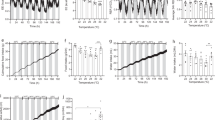Summary
It is well known that cold and diet-induced thermogenesis, which is mediated in small rodents by the hypothalamic-noradrenergic fibersbrown adipose tissue axis, is impaired in genetically obese mice. To test whether these adaptive mechanisms are also impaired in obese humans, 12 young males who were otherwise healthy (6 lean and 6 obese) were examined. The obese subjects had an early-onset type of obesity with a strong family history of it as well. Deep body temperature was measured by using a deep body thermometer furnished with three thermocouples. They were respectively placed on the sternum, on the interscapular area immediately under the neck (HIS), and on the 4th intercostal space (LIS) in order to study core temperature as well as heat production where brown adipose tissue could also be present in adults. Both lean and obese subjects were kept in a thermoneutral environment (28° C) until they reached a steady-state body temperature and then rapidly transferred into a cold room (6–8° C) where they remained up to 60 min. Body temperature decreased in both groups, but the decrease was more marked in the obese individuals on the sternum (P<0.01), on HIS (P<0.05) and on LIS (P<0.05) when compared to lean individuals. In conclusion, cold-induced thermogenesis is impaired in familial early-onset human obesity and in genetically obese mice.
Similar content being viewed by others
Abbreviations
- BAT:
-
brown adipose tissue
- BMI:
-
body mass index
- HIS:
-
high interscapular area
- LIS:
-
low interscapular area
References
Durnin JVGA, Lonergan ME, Good J, Ewan A (1974) Cross-sectional nutritional and anthropometric study, with an interval of 7 years, on 611 young adolescent school children. Br J Nutr 32:169–179
Griffiths M, Payne PR (1975) Energy expenditure in small children of obese and non-obese parents. Nature 260:698–700
Sveger T, Lindberg T, Weibull B, Olssen VL (1975) Nutrition, overnutrition and obesity in the first year of life in Malmo, Sweden. Acta Paediatr Scand 64:635–639
James WPT, Trayhurn P (1981) Obesity in mice and men. In: Beers RF jr, Barrett EG (eds) Nutritional factors: modulating effects and metabolic processes. Raven Press, New York, pp 123–138
Cawthorne MA (1982) Metabolic aspects of obesity. Mol Aspects Med 5:293–400
Thurlby PL, Trayhurn P (1979) The role of thermoregulatory thermogenesis in the development of obesity in genetically obese (ob/ob) mice pair fed with lean siblings. Br J Nutr 42:377–385
Thurlby PL, Trayhurn P (1980) Regional blood flow in genetically obese (ob/ob) mice. The importance of brown adipose tissue to the reduced energy expenditure on non-shivering thermogenesis. Pflugers Arch 385:193–201
Jung RT, Shetty PS, James WPT, Barrand MA, Callingham BA (1979) Reduced thermogenesis in obesity. Nature 279:322–323
Himms-Hagen J, Desautels MA (1978) A mithocondrial defect in brown adipose tissue of the obese (ob/ob) mouse: reduced binding of the purine nucleotides and a failure to respond to cold by an increase in binding. Biochem Biophys Res Comm 83:628–634
Goodbody AE, Trayhurn P (1981) GDP binding to brown adipose tissue mitochondria of diabetic obese (db/db) mice. Biochem J 194:1019–1021
Eaton JM (1972) The distribution of brown adipose tissue in the human. J Anat 112:35–39
Rothwell NJ, Stock MJ (1979) A role for brown adipose tissue in diet induced thermogenesis. Nature 281:31–35
Contaldo F, Presta E, Di Biase G, Scalfi M, Mancini M, Maddalena G, De Divitiis O (1981) Preliminary evidence for brown fat abnormality in human obesity. In: Cioffi LA, Van Itallie TB, James WPT (eds) The body weight regulatory system: normal and disturbed mechanisms. Raven Press, New York, pp 143–146
Garrow JS (1978) Regulation of energy balance. In: Bray GA (ed) Recent advances in obesity research, II. Technomic West Point, Connecticut, pp 200–210
Dauncey MJ (1980) Metabolic effects of altering the 24 hours energy intake in man, using direct and indirect calorimetry. Br J Nutr 43:257–269
Wyndham CX, Williams CG, Loots H (1968) Reactions to cold. J Appl Physiol 24:282–287
Andrews F, Jackson F (1978) Increasing fatness inversely related to decreasing temperature in young men and women during cold exposure. Ir J Med Sci 147:329–330
Fox RH, Solman AJ, Isaacs R, Fry AJ, MacDonald JC (1973) A new method for monitoring deep body temperature from the skin surface. Clin Sci 44:81–86
Solman AJ, Dalton JCP (1973) New thermometers for deep tissue temperature. Biomed Engineering 8:432–435
Ball SG, Chalmers DMcM, Morgan AG, Solman AJ, Losowsky MS (1973) A clinical appraisal of transcutaneous deep body temperature. Biomedicine 18:290–294
Anderson KL (1963) Comparison of Scandinavian Lapps, Arctic fishermann and Canadian Arctic indians. Fed Proc 22:834–839
Scholander PF, Hammel HT, Hart JS, Le Messurier DH, Steen J (1958) Cold adaptation in Australian aborigines. J Appl Physiol 13:211–218
Windham CX, Harrison JF (1958) Adjustment at cold of bushmen in the Kalahari desert. J Appl Physiol 13:219–225
Stock MJ, Rothwell NJ (1982) Obesity and leanness: basic aspects. John Libbey, London
Author information
Authors and Affiliations
Rights and permissions
About this article
Cite this article
Contaldo, F., Scalfi, L., Coltorti, A. et al. Reduced cold-induced thermogenesis in familial human obesity. Klin Wochenschr 64, 177–180 (1986). https://doi.org/10.1007/BF01713459
Received:
Revised:
Accepted:
Issue Date:
DOI: https://doi.org/10.1007/BF01713459




